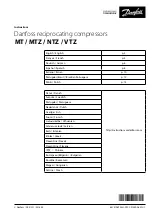
13-18-612 Page 8
1-1
SECTION 1
GENERAL INFORMATION
Figure 1-1
– COMPRESSOR CYCLE
COMPRESSOR
– Your Gardner Denver Rotary Screw package is fitted with one (1) single stage, positive
displacement rotary compressor using meshing helical rotors to effect compression. Each pair of rotors is supported
between high capacity anti-friction bearings located outside the compression chamber. Single cylindrical roller
bearings are used at each end of the rotors to carry the radial loads. An additional angular contact ball bearing is
located at the discharge end of each rotor to carry axial thrust loads - the arrangement of both roller and ball bearings
is designed to withstand reverse axial thrust loads. The main rotor sits next to its gate companion, in a side-by-side
configuration.
COMPRESSION PRINCIPLE
(
Figure 1-1
) - Compression is accomplished by the main and gate rotors
synchronously meshing in a one-piece cylinder. The main rotor has four (4) helical lobes, 90
apart, which mesh with
six (6) helical grooves, 60
apart, on its matching gate rotor.
The air inlet port is located on top of the compressor cylinder, and the discharge port is located below the compressor
cylinder. The compression cycle begins as the rotors unmesh at the inlet port and air is drawn into the cavity between
the main rotor lobes and gate rotor grooves (A). When the rotors pass the inlet port cutoff, air is trapped in the
interlobe cavity and flows axially with the meshing rotors (B). As meshing continues, more of the main rotor lobe
enters the gate rotor groove, normal volume is reduced and pressure increases.
Oil is injected into the cylinder to remove the heat of compression and seal internal clearances. Volume reduction
and pressure continues to increase until the air/oil mixture trapped in the interlobe cavity by the rotors passes the
discharge port (C). Each rotor cavity follows the same “fill-compress-discharge” cycle in rapid succession to produce
a discharge air flow that is continuous, smooth and shock free.
AIR FLOW IN THE COMPRESSOR SYSTEM
(
Figure 4-2
, page 30) - Air enters the air filter and passes through the
inlet control (poppet) valve to the compressor inlet flange. After compression, the air/oil mixture enters the oil
reservoir where most of the entrained oil is removed by change of direction and impingent. It is further removed by
centrifugal action and drained down into the reservoir. The air and remaining aerosols pass into twin coalescing
elements where the oil is captured and drained through a drain line back into a lower pressure region of the
compressor. The nearly oil-free air passes through the minimum pressure valve, aftercooler, optional moisture
separator, and finally to the distribution network.
LUBRICATION, COOLING AND SEALING
(Figure 4-2, page 30) - Oil is forced by differential pressure from the oil
reservoir through the oil cooler, servo-driven oil mixing valve, oil filter, and enters the compressor. A portion of the oil
is directed to internal passages within the compressor to lubricate the bearings and shaft oil seals. The balance of
the oil is injected into the compressor rotors to remove the heat of compression, seal internal clearances and
lubricate the rotors.
Summary of Contents for AirSmart VS80-110B
Page 33: ...13 18 612 Page 32 4 7 300CGE546 04 Ref Drawing Page 2 of 4...
Page 34: ...13 18 612 Page 33 4 8 300CGE546 04 Ref Drawing Page 3 of 4...
Page 35: ...13 18 612 Page 34 4 9 300CGE546 04 Ref Drawing Page 4 of 4...
Page 37: ...13 18 612 Page 36 4 11 301CGE546 B Ref Drawing Page 2 of 4...
Page 38: ...13 18 612 Page 37 4 12 301CGE546 B Ref Drawing Page 3 of 4...
Page 39: ...13 18 612 Page 38 4 13 301CGE546 B Ref Drawing Page 4 of 4...
Page 41: ...13 18 612 Page 40 4 15 302CGE546 05 Ref Drawing Page 2 of 4...
Page 42: ...13 18 612 Page 41 4 16 302CGE546 05 Ref Drawing Page 3 of 4...
Page 43: ...13 18 612 Page 42 4 17 302CGE546 05 Ref Drawing Page 4 of 4...
Page 45: ...13 18 612 Page 44 4 19 303CGE546 B Ref Drawing Page 2 of 4...
Page 46: ...13 18 612 Page 45 4 20 303CGE546 B Ref Drawing Page 3 of 4...
Page 47: ...13 18 612 Page 46 4 21 303CGE546 B Ref Drawing Page 4 of 4...
Page 70: ...13 18 612 Page 69 9 2 Figure 9 1 MINIMUM DISCHARGE PRESSURE CHECK VALVE...
Page 86: ...NOTES...
Page 87: ...NOTES...










































